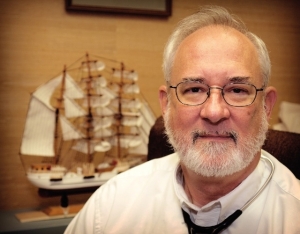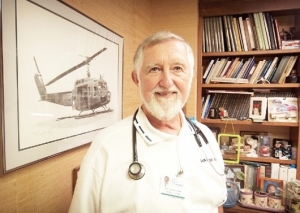Family physicians -- a vanishing breed
By Phyllis Moore
Published in News on July 20, 2011 1:46 PM

News-Argus/MICHAEL K. DAKOTA
Dr. James Stackhouse of Goldsboro Medical Specialists will soon be the only physician in the practice when longtime partner Dr. Sam McLamb retires later next month. Dr. Stackhouse says family practices are rapidly dwindling in number because fewer medical graduates are entering the field.

News-Argus/MICHAEL K. DAKOTA
After 32 years, Dr. Sam McLamb, of Goldsboro Medical Specialists, is retiring next month. Many communities, just like Goldsboro, are losing family physicians.
Another area doctor is retiring next month.
But when Dr. Sam McLamb of Goldsboro Medical Specialists hangs up his stethoscope on Aug. 24, more than a family physician will be lost.
In some ways, it's another nail in the looming coffin of family practices around the country.
McLamb's partner, Dr. James Stackhouse, predicted years ago that primary care medicine was at risk because fewer medical graduates were entering the field.
He even took his concerns to associations he belonged to, including the American College of Physicians, the nation's largest specialty agency representing internal medicine physicians like Stackhouse.
"I came out and said there was a catastrophe coming out in family practice," he said, explaining that more graduates are entering specialized fields or becoming hospitalists. "It's been that way for about 15 years."
Family practice residencies are not being filled, Stackhouse said, with fewer than half today than there were 20 years ago.
"Internal medicine has not grown that much," he said. "It has to do with federal funding of residency programs. They have been restricted or cut back."
And yet internal medicine -- specializing in the prevention, detection and treatment of illness in adults -- is the "backbone" of the nation's health care system, says a 2006 report released from the American College of Physicians on "The Impending Collapse of Primary Care Medicine and Its Implications for the State of the Nation's Health Care."
"Immediate and comprehensive reforms are required to replace systems that undermine and undervalue the relationship between patients and their personal physicians," the report said. "If these reforms do not take place, within a few years there will not be enough primary care physicians to take care of an aging population with increasing incidences of chronic diseases."
Within the next decade, the report predicted, baby boomers will begin to be eligible for Medicare. By the year 2030, one-fifth of all Americans will be at least 65 and most assuredly, as time passes and the population inches up to age 85, so will the need to treat multiple chronic conditions.
Stackhouse and McLamb began making their own preparations a few years ago.
"We sold the office five years ago in anticipation of one of us dying or whatever," said Stackhouse, who has since purchased another physician's office at Ash and Audubon streets.
They also notified patients in the practice of McLamb's impending retirement.
"We sent out letters to the patients the last two years," Stackhouse said. "I have been able to take about one-third of those patients, but the other two-thirds have been trying to find another doctor."
His office staff also called around to area primary care practices to lay the groundwork.
"There are seven or eight that were taking new patients," he said. "We had one practice that told us they were not taking new Medicare or Medicaid (patients). ... Probably out of 800, 900 patients who received letters, that they need to find another doctor, we have only had 70 or 80 send us transfer forms for their charts.
"We have seen at least 60 or 70, it really isn't many, that have sent us forms to transfer their records to other offices."
While it sounds promising at the outset, he also admitted that "odds are good" that many patients transferring to another practice might be seen by nurse practitioners or physician's assistants rather than a doctor, as "that's the trend."
Calls to a few area practices proved that. While places like Immediate Care accept Medicare, established practices like Eastern Medical Associates says it does, too, but is not taking new patients at this time. Eastern Medical Associates' office in Pikeville, however, is taking new patients, including those who are on Medicaid. Goldsboro Family Physicians is accepting new patients, but staff said there is currently a six-month wait to get in as a new patient. A physician's assistant has been hired, though, offering more availability to be seen sooner.
Stackhouse did not opt to go that route.
"I will be the sole physician," he said. "I thought about getting a nurse practitioner but that just has not been my practice style."
Meanwhile, he continues to monitor progress of the medical field.
Government has been pushing for more medical students to pursue training in internal medicine and family practice.
In 2010, Congress passed legislation as part of the Affordable Care Act, making health insurance coverage available to nearly all Americans by 2014 and addressing the shortage of primary care physicians by reforming payments systems and funding primary care training programs.
"We are very dependent on having international medical graduates to provide services," Stackhouse said. "Most of the primary care slots, I think many of the primary care slots, are being filled by international medical graduates. They get their visa for coming to work in underserved areas.
"We have been very dependent on that in primary care for a number of years. ... These people are well-trained folks but they're not going to stay a long time."
One reason primary care candidates have decreased is money.
"Certainly income is a big one -- someone going into a specialty will make three to four times more than someone who goes into family practice," Stackhouse said. "And medical students are now coming out with an average of $130,000 of debt. They're coming out of residency, are 30 years old, it's basically a different lifestyle expectancy.
"They want security, want to get out of debt, and are not going to a rural area."
At the same time, Stackhouse pointed out, there are other problems looming, among them the very basic "access to care."
"Life expectancy in this country is dropping right now," he said. "We're falling behind -- the U.S. ranks 30th in health care (in the world)."
He praised outlets like the WATCH mobile van, which serves a large population of uninsured and underinsured residents with acute care needs.
The hospital emergency room is likewise seeing elevated numbers, prompting additional construction to accommodate the more than 55,000 patient visits a year.
"Our population has not doubled, so the average person in this county is in the ER -- that's access to care," Stackhouse said.
